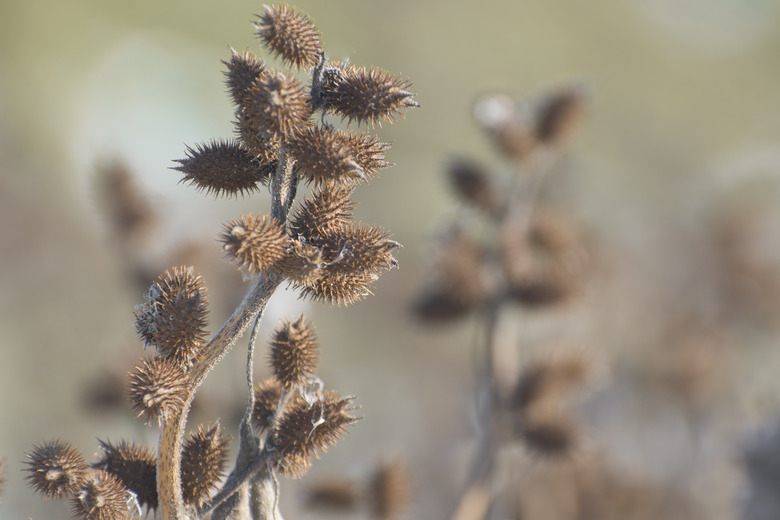How To Get Rid Of Cockleburs
We may receive a commission on purchases made from links.
If common cocklebur (Xanthium strumarium) has invaded your lawn or garden, you needn't fret about how to get rid of it. The burs of this broadleaf, summer annual can make it painful to eliminate by hand pulling, but you can also remove it with hoeing or herbicide. Common cocklebur seeds are fatal if ingested by humans or animals and can cause a rash when handled by some people. Before working with this invasive weed, protect yourself by wearing heavy gloves, long sleeves, and long pants.
Identifying Common Cocklebur
Identifying Common Cocklebur
Common cocklebur can spring up anywhere the soil has been disturbed — flower beds, newly seeded lawns, and vegetable gardens — including elevations up to 1,600 feet. When it first emerges from the ground, leaves sprout opposite each other on the stem, but as it grows, they become staggered up the stem.
The plant grows about 4.5 feet tall. Stems don't have prickly spines, but do have purple or black splotches. Flowers bloom midsummer and continue into fall, giving way to seed pods covered with spines called burs. Each pod contains two seeds that regenerate the plant each year. Stop these seeds from forming to get rid of cockleburs from the yard.
Hoeing and Hand Pulling
Hoeing and Hand Pulling
If a small area of the yard has been invaded with cocklebur, hand pulling and hoeing work well to remove the plant. These methods work best when done before burs form so seeds aren't dispersed when handling plants. When hoeing, uproot the plant with the hoe and pull the whole plant out of the soil. Compost the entire plant. If seeds exist, the heat of a properly maintained compost pile will kill them. Pick up any fallen burs to prevent reseeding. It may take several sessions of pulling and hoeing to eradicate all cocklebur plants, but the extra effort is good for the environment and gives you a free workout.
Mowing Common Cocklebur
Mowing Common Cocklebur
Mowing common cocklebur when it is young keeps it from setting seed and spreading. The key is to mow frequently and before the seeds form. If cocklebur is growing in your lawn, set the mower to the proper mowing height for the type of grass and mow as least once per week (more frequently if you see burs begin to form on plants). If plants have formed seed heads, keep seeds from spreading by using a bagger attachment on the mower. Dispose of bagged clippings and seeds with other lawn waste through your municipal yard waste hauler.
Spraying It Away
Spraying It Away
Cocklebur around the lawn can be treated with a post-emergent herbicide if hand pulling and mowing don't work. This type of herbicide is designed to kill the weed without harming most grass types. Check the label to see if a herbicide is safe for your grass species and heed all warnings, such as wearing eye protection, when using the product.
One type of pre-emergent herbicide safe for many types of grass is a formulation of 2,4-D, fluroxypyr, and dicamba. Use it by mixing 0.75 fluid ounce of herbicide in 5 gallons of water for every 1,000 square feet you want to treat. When weeds are actively growing, thoroughly coat cockleburs with the herbicide mix. Don't spray on windy days when the herbicide could drift onto ornamental or vegetable plants. If spray lands on grass, it may yellow but will recover in about one week. If the cockleburs don't die within four weeks, re-treat them.
